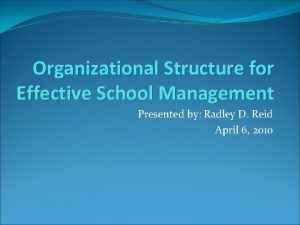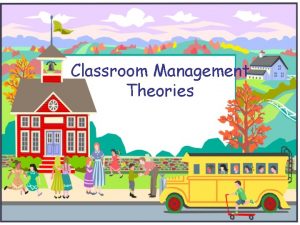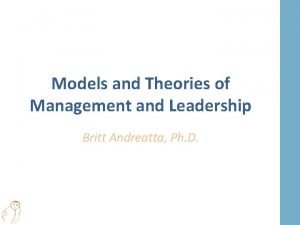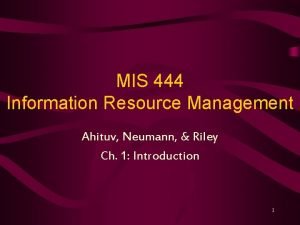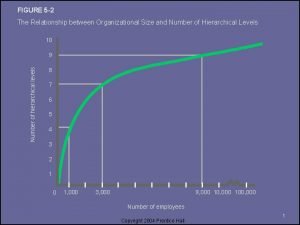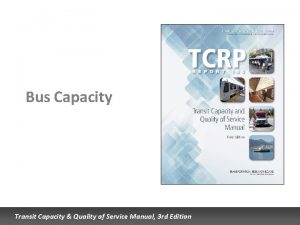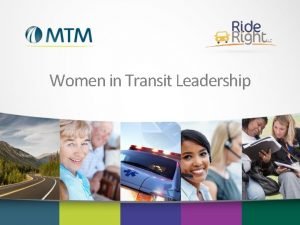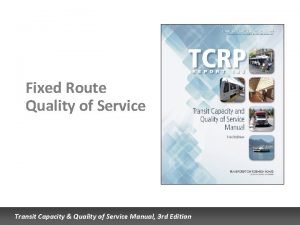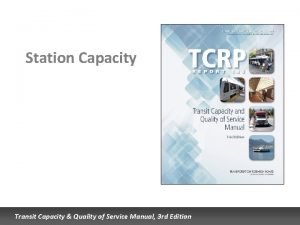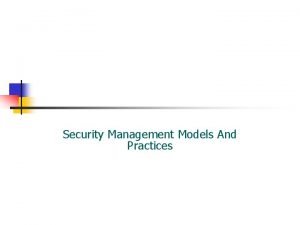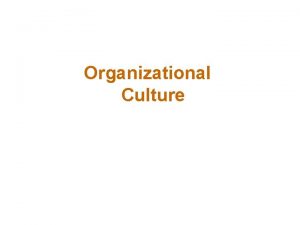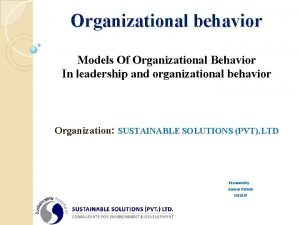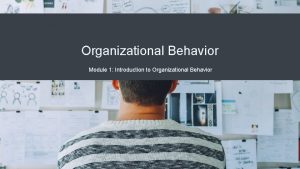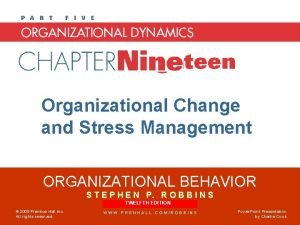MODULE 5 TRANSIT MANAGEMENT Organizational Models and Transit





![Sample Means/Ends Mission Statement [From the Rochester-Genessee RTA] • MEANS MISSION: To be a Sample Means/Ends Mission Statement [From the Rochester-Genessee RTA] • MEANS MISSION: To be a](https://slidetodoc.com/presentation_image_h2/cc0371910de7867d47ebb5858a82e390/image-6.jpg)







- Slides: 13

MODULE 5 TRANSIT MANAGEMENT Organizational Models and Transit System Stakeholders

Overall Context Transit management is highly varied in terms of organizational models and the specific functions performed. This variety reflects transit’s unique challenge to be efficient and businesslike, but also to provide a public service. Different organizational models and structures also reflect the history, funding, and politics of transit in each region.

Learning Objectives • Recognize the various organizational models among transit systems • List the various functions performed by transit management • Describe how management interacts among various internal and external stakeholders, and how the interests of those stakeholders may conflict with one another. • Explain what ethical challenges are faced by a transit system CEO. • Effectively use statistical indicators to measure and benchmark transit system performance. • Identify the role of organized labor in a transit organization.

Organizational Models • Management reports to a board of directors • Management reports to a state, regional, or local agency • Management reports to an independent Administrator • Transit operates as a municipal or county department • Some transit operations are outsourced to a private operator or operators • Full turnkey operations • Transit operated by social service agencies in small urban and rural areas

Typical Board of Directors Functions • Responsible for overall policy direction • Determines the organization’s mission, vision, and purpose • Sets policy; defines and measures success Ø Adopts important program strategies; sets fares Ø Adopts the annual operating budget and work plan Ø Adopts capital plans Ø Maintains communications with elected officials and other external stakeholders Ø Adopts ethics policies Ø Hiring of transit system CEO • Acts as the “Voice of the Owners”
![Sample MeansEnds Mission Statement From the RochesterGenessee RTA MEANS MISSION To be a Sample Means/Ends Mission Statement [From the Rochester-Genessee RTA] • MEANS MISSION: To be a](https://slidetodoc.com/presentation_image_h2/cc0371910de7867d47ebb5858a82e390/image-6.jpg)
Sample Means/Ends Mission Statement [From the Rochester-Genessee RTA] • MEANS MISSION: To be a responsible employer, providing quality transportation services in a cost-efficient manner. • ENDS MISSION: To provide efficient, sustainable, public transportation that takes people where they want to go when they want to go there, with a commitment to customer satisfaction and to maintaining reasonable fares.

Transit Management Functions • The actual functions performed by transit organizations differ widely from one to another. • As a result, the skill sets required for transit system GM’s/CEO’s have evolved.

Internal Functions • Maintenance • • • Finance Purchasing Transportation Human Resource Training Information Technology

External Functions • Landscape Assessment • Marketing • Community Interaction Planning • Public Relations • Service Delivery

Transit System Stakeholders Internal Stakeholders may include: • Employees Ø Union • Operating and administrative departments • Safety committees • Compliance units • Board members • Project managers

External Stakeholders May Include: • Elected Officials • City and county councils, state legislature, congress • Mayors, selectmen, governor • Agencies • Federal Transit Administration • Metropolitan Planning Organization • State and regional transportation and planning agencies • Other Federal /state regulatory agencies (DOL, DOT, DOJ, EPA, etc. ) • Interested Parties • Passengers and rider groups • Interest groups (e. g. , Sierra • • • Club, AARP, disability advocates, etc. ) Vendors, contractors, and consultants Press and news media Community/neighborhood organizations Business community Associations (local, state, and national)

Management Challenges • Building consensus among stakeholders • Managing conflict between stakeholders • Business leadership

Ethical Challenges • Board politics • Hiring decisions • Procurements • Social justice and diversity
 What is the difference between modals and semi modals?
What is the difference between modals and semi modals? Organizational structures in schools
Organizational structures in schools C device module module 1
C device module module 1 Ginotts model
Ginotts model Management models and theories
Management models and theories Change and stress management
Change and stress management Information resources management
Information resources management Organizational theory and management
Organizational theory and management Module 4 operating systems and file management
Module 4 operating systems and file management Transit capacity and quality of service manual
Transit capacity and quality of service manual Mtm transit maintenance
Mtm transit maintenance Transit capacity and quality of service manual
Transit capacity and quality of service manual Transit capacity and quality of service manual
Transit capacity and quality of service manual Security management model
Security management model

